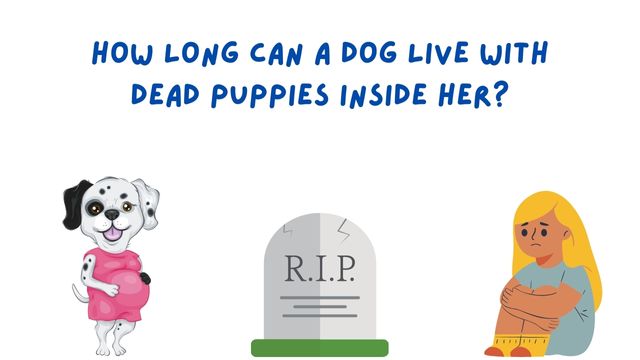Pregnancy in dogs is a delicate period that warrants close monitoring and extra care. One of the things confusing and scary to owners is the possibility of puppy death in pregnant females.
How long a dog can live with dead puppies inside her depends on whether the dead puppy was reabsorbed, mummified, or decomposing. Typically the earlier stage of pregnancy the better chance the puppies are absorbed which rarely causes issues.
While mummified puppies are a rare scenario, you will still need to take your dog to the vet for removal and if the puppies are decomposing it could be fatal for the mother if left untreated for a couple of days.
In this article, we will discuss fetal death in dogs – the potential causes and the consequences for the mother.

Signs of Dead Puppies In The Womb
Your dog will not show any signs of dead puppies in the womb during first trimester or first half of the pregnancy. No signs and symptoms are present in the case of mummification.
However, if the puppies are dead in the womb and starting to decompose, the mother will experience progressing and potentially life-threatening changes.
Signs of dead puppies in the womb include:
· Pus-like vaginal discharge
· Fever due to the infection
· Absent food and water intake.
Signs of A Dog Losing Her Puppies: Discharge

The telltale signs of miscarriage in dogs are through discharge. This includes:
· Abnormal vaginal discharge (brown, yellow, green, black, and with a repulsive smell)
· Abdominal pain (usually manifested with hunched body posture)
· Fever (increased body temperature), lethargy, and disinterest in everyday activities.
A pregnant dog may lose her puppies at any time of the pregnancy. If the loss occurs within the first half of the pregnancy (first 30-45 days), the dead fetuses will get reabsorbed into the body. In such cases, the entire pregnancy may go unnoticed.
On the other hand, if the fetuses die in the second half of the pregnancy, they cannot be absorbed and usually start decomposing inside the mother. This is a potentially fatal outcome and requires urgent veterinary help.
Another option is for the dead puppies to get mummified – a process in which the mother’s body creates a protective membrane around the dead fetuses to protect itself. However, eventually, the protective membrane may get infected and cause problems.
What Happens if My Dog Has Dead Puppies Inside Her?
If you suspect your dog’s puppies are dead, you need to call the vet and schedule an urgent examination. The vet can confirm your suspicions using an abdominal ultrasound examination. Basically, the vet will search for heartbeats, and if they are absent, the puppies are dead.
The next step would be to remove the dead puppies as their presence within the womb is life-threatening. In such a case, the vet will perform a surgery – similar to a Caesarean section.
Depending on how long the puppies were dead inside the uterus, there can be permanent uterine damage. If this occurs, the vet will recommend removing the puppies together with the uterus or, in other words performing a spay procedure.
Can a Dog Deliver Dead Puppies?
No, a dog cannot deliver dead puppies. This is because puppies generate the signal necessary for alerting the mother’s body to start giving birth. Therefore, if the puppies are dead, there will be no birth-giving signal.
The only way of giving birth to a dead puppy is if the puppy died after the partus started. For example, if there was a lack of contraction and the puppy suffocated while spending too much time inside the birth canals.
How to Remove Dead Puppies From The Mother?
You should never try to remove a dead puppy from the mother. Because of the complications that arise you will need to take the mother to the vet or animal hospital immediateky
Dead Puppy Stuck in Birth Canal
Depending on the exact position of the fetus within the birth canal, the vet may use a special tool called forceps to get the puppy out. On the other hand, if performing a surgical procedure for removing the dead puppies and uterus, the vet will try to access the puppy stuck in the birth canal through the abdomen.
Summing Up: Dead Puppies Stuck In Womb
Sadly, just like in people, fetal death is a possibility in dogs too. There is a number of causes that can result in such a scenario – some preventable, others not. In cases of fetal damage and death, the goal is to protect the mother and save her life.
Therefore, if your dog is pregnant, regular check-ups at the vet’s office are imperative. It is also critical to call the vet as soon as you notice something might be going on with your pregnant dog. Prompt attention and treatment can be life-saving for the mother as well as for the puppies.

